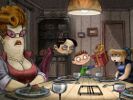Eye For Film >> Movies >> The Suicide Shop (2012) Film Review
Somewhere in a time not very far from now, in the grey backstreets of Paris where the residents shuffle glumly about their business or tumble from buidlings in a bid to take the quick way out, lies a shop offering a warm haven for the heartsick.
Killing yourself, you see, is forbidden in public, which means business is booming at the Tuvache family's Suicide Shop. Dad Mishima (a nod to famous Seppuku suicide Yukio Mishima) and mum Lucrezia (a name bolstered by a ton of references including the classical suicide, the infamous murderous Borgias and, handily, derived from the Latin word for profit) live above the shop with their two kids. The children, in turn, are waspishly named Marilyn and Vincent (after Monroe and Van Gogh, both "possible suicides").

Their shop is an Aladdin's cave of suicide paraphernalia, from ropes in all lengths to a plethora of poisons and razor blades - blunt, or rusty if you'd rather get tetanus than cut yourself to shreds. There's more than a touch of The Addams Family and The Munsters to this (not just in the sharing of Marilyn Munster's name but in the Gomez-like look of Mishima). But the macabre end of Sylvain Chomet's output, particularly The Old Woman And Her Pigeons, is also a touchstone, while the musical numbers that pepper the action are likely to put many in mind of Tim Burton - though, sadly, the tunes aren't in the same class as those of his frequent collaborator Danny Elfman.
Into the Tuvache's maudlin little world comes new family member Adam, bouncing and smiling from the moment of his birth. He's not too sure about the suicide biz and soon he and a few like-minded school chums are plotting to change things, meanwhile Mishima is beginning to find the twin strains of peddling death and his irrepressible youngest son, all a bit too much.
And 'a bit too much' is the problem with Patrice Leconte's animation, which seeks to shroud its death and more adult themes beneath an unnecessarily thick layer of sugar, in a bid to make it palatable for younger audiences. Parents, incidentally, should be warned that though the scenes of death here are comically presented, they will still be too grim for very young children. In fact, the initial scenes of macabre mayhem are great in terms of black humour for adults - a sequence involving a homeless man a plastic bag and a piece of tape is particularly memorable - and there are plenty of sly winks towards teenagers' miserable attitude and gothic tendencies. The story of how Alan tries to help Marilyn to see herself differently - while giving his friends a good eyeful - is also a lot of fun.
But this is a film of two halves, with the half involving sweetness and light muddled and limp in comparison to its tougher, more sinister flipside, while the ending is almost unforgivably trite. Even the songs fall much flatter when they aim for cute rather than cutting and while subtitling them in rhyme is a smart idea in principle, it leads to some odd translations, for example, "We were stupid, Now it's all limpid".
Despite its plot and tone drawbacks, the detailed animation is never anything but beautiful, although I doubt seeing it in 3D - I watched the 2D version - would add a great deal. It's a shame Leconte felt the need to hedge his bets audience-wise, doing so feels like a missed opportunity.
Reviewed on: 22 Nov 2012

















